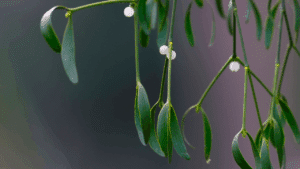
Mistletoe (Viscum album)
Mistletoe (Viscum album) Every Christmas, mistletoe hangs above doorways, inviting

If you’ve ever grown your own fruit, vegetables, or even a few pots of herbs on the windowsill, you’ll know that plants can be fussy. They wilt, they yellow, they get leggy or fail to flower; and sometimes, despite our best efforts, we can’t quite figure out what they’re missing.

Homeopath and CHE Community Manager
One of the most common (but often overlooked) nutrients in soil is potassium. It’s essential for plant health, yet easily depleted, especially in overworked soil or areas with heavy rain. And interestingly, when our usual gardening tricks don’t quite cut it, certain homeopathic potassium-based remedies (the ‘Kali’ remedies) can offer gentle but powerful support.
Let’s unpack that.
Potassium isn’t just a bonus nutrient, it’s vital. Plants need it in relatively large amounts to do things like:
If your soil is lacking in potassium, you might notice symptoms like:
Potassium can get washed out of the soil quite easily, especially if it’s sandy or you’ve had a lot of rain. Adding compost, wood ash, or seaweed is one way to help; but sometimes, especially in sensitive or struggling plants, it helps to go a step further.
This is where things get a little more energetic.
In homeopathy, there’s a whole group of remedies based on potassium salts, all of which start with the word Kali (from “kalium”, the Latin name for potassium). These remedies don’t add potassium to the soil in the usual sense, they work on a different level, stimulating the plant’s own ability to recover and rebalance.
Here are a few that are useful in the garden:
Kali carbonicum
Great for plants that look stiff, upright, and almost brittle; like they’ve lost their flexibility. It can help those with dry or yellowing leaf margins, and plants that tend to snap or collapse easily.
Kali muriaticum
This one comes into its own when there’s a sense of congestion; sticky sap, thickened growth, or fungal issues. I’ve used it on plants with thick, damp-looking leaves that just don’t seem to be “breathing” properly.
Kali sulphuricum
If you’ve had a run of damp, grey weather and everything looks a bit sluggish, this remedy can help shift that energy. Good for fungal-prone plants and those that seem stuck in late stages of recovery.
Kali phosphoricum
The ultimate pick-me-up. Use this after transplanting, overwatering, heat stress, or just when your plants look a bit shell-shocked. It gives a tired plant a little nervous system boost (yes, plants have one too, sort of!).
It’s simple:
It’s not an exact science, but then, gardening rarely is.
Potassium is often described as the “quality nutrient”, and for good reason. It quietly supports so many of the processes that help plants thrive, from sturdy stems to sweet, full fruit. But when the usual fixes aren’t working, and your gut tells you the plant is struggling on a deeper level, the Kali remedies can be a beautiful way to nudge things back into balance.
They’re gentle, non-toxic, and surprisingly effective, especially when combined with mindful soil care and observation.
If you’ve never tried homeopathy in the garden, give it a go. Start with just one or two remedies and keep notes. You might be surprised by what unfolds.
If you found this post helpful, you’ll love what’s waiting for you inside CHE Pro; our professional membership for homeopaths who want to keep growing, learning, and feeling supported in practice.
Whether you’re newly qualified or decades into practice, CHE Pro is your home for ongoing support and brilliant homeopathic education.
We’d love to welcome you in.
Disclaimer
The content shared here is intended for informational purposes only and should not be considered a replacement for professional medical advice, diagnosis, or treatment from a qualified and licensed healthcare provider. The views and opinions expressed in this presentation are those of the presenter and do not necessarily represent those of CHE or any affiliated organizations.

Mistletoe (Viscum album) Every Christmas, mistletoe hangs above doorways, inviting

Your Guide to Calc Tissue Salts Tissue salts, also known

Natrum Muriaticum vs Nitric Acid: When Defensive Minds Look Alike
